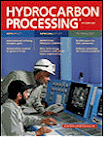Display problem ? Click HERE
Subscribes to FREE Hydrocarbon Processing
 A system may operate in two (2) modes operation. Mode 1 involve water and mode 2 involve air. Both conditions may lead to over-pressure of the system and it is protected by a pressure relief valve (PSV). The PSV is located 10 meter above the a vessel designed to ASME Section VIII with design pressure of 20 barg. How shall we determine the set pressure and maximum permissible line loss of the PSV ?
A system may operate in two (2) modes operation. Mode 1 involve water and mode 2 involve air. Both conditions may lead to over-pressure of the system and it is protected by a pressure relief valve (PSV). The PSV is located 10 meter above the a vessel designed to ASME Section VIII with design pressure of 20 barg. How shall we determine the set pressure and maximum permissible line loss of the PSV ?
Only Non-Recoverable loss includes in PSV inlet line loss
PSV inlet line NON-RECOVERABLE losses shall be limited to 3% of set pressure. This requirement comes from ASME Section VIII, Div 1, Appendix M and also found in API RP-520 Part II. NON-RECOVERABLE losses is mainly the line frictional loss exclude the static pressure loss.
Only Non-Recoverable loss includes in PSV inlet line loss
PSV inlet line NON-RECOVERABLE losses shall be limited to 3% of set pressure. This requirement comes from ASME Section VIII, Div 1, Appendix M and also found in API RP-520 Part II. NON-RECOVERABLE losses is mainly the line frictional loss exclude the static pressure loss.
Why not include the static pressure loss in inlet line loss ?
The main reason is any difference in static pressure between the PSV and the protected system has been accounted for during selection of PSV set pressure. For example, a vessel with design pressure of 10 barg protected by PSV located 10 meter higher than the vessel, the static loss is approximately 1 bar (for water). The PSV set pressure shall not more than 10-1 = 9 barg.
Determine set pressure with maximum fluid density & static difference
Whenever determining the set pressure for a PSV involving vapor and liquid relief, the fluid with highest density (water in this case) shall be considered first.
Case studies
Refer to above...
Mode 1 : Water
Water density = 1000 kg/m3 (approx.)
Design pressure = 20 barg
Static pressure loss = 10 x 9.81 x 1000 / 100000 = 0.981 bar.
Maximum Set pressure of PSV = Design pressure - Static pressure loss
Maximum Set pressure of PSV = 20 - 0.981 = 19.019 barg.
Fix Set pressure of PSV at 19 barg (instead of 20 barg)
PSV starts to open at 19 barg when operating pressure at vessel is 20 barg.
PSV relieving pressure = 110% x 19 barg = 20.9 barg (lower than Maximum Allowable Relieving pressure of 22 barg).
Maximum Line loss = 3% of Set pressure = 3% x 19 bar = 0.57 bar.
Maximum PSV Reseat pressure = 19 - 0.57 = 18.43 barg.
Mode 2 : Air
Air density = 26 kg/m3 (approx.)
Design pressure = 20 barg
Static pressure loss = 10 x 9.81 x 26 / 100000 = 0.025 bar (~ Negligible)
From mode 1, Set pressure of PSV is 19 barg.
PSV starts to open at 19 barg when operating pressure at vessel is 19 barg.
Thus maximum operating pressure is only 19 barg.
Concluding Remarks
Static pressure loss affecting the PSV set pressure whilst only non-recoverable line loss to be taken for PSV inlet line loss. Ths concept is simple however mistake is always made in this area.
Related Posts
- How to Resolve Issue with PSV Inlet Line Loss Exceeded 3% of Set pressure
- Concerns & Recommendations on PSV INLET line
- Few Concerns & Recommendations of PSV Discharge Tail pipe
- Where to Locate the PSV Inlet Nozzle ?
- Is Single PSV Protection Sufficient ?
- PSV Chaterring is Destructive...The ways to Prevent...
- Relate PSV Relieving Flow to Stamped Capacity
Good info posted here. I learned some stuff about PSV that I didn't know prior to reading this.
ReplyDelete-Jack